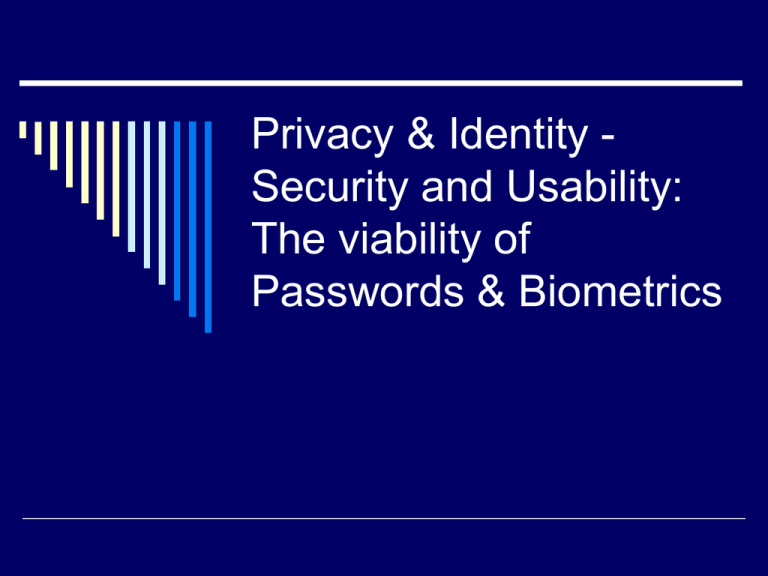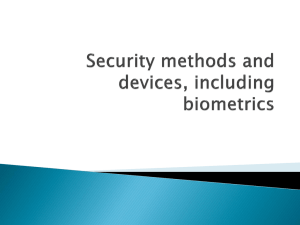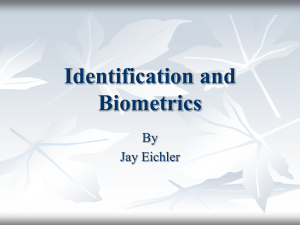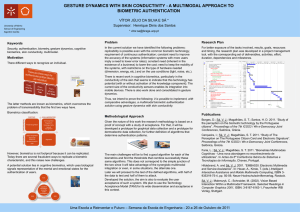Biometrics - DePaul University
advertisement

Privacy & Identity Security and Usability: The viability of Passwords & Biometrics Introduction Name: Orville Wilson Alumni at DePaul University Doctoral Student Currently work for an Information Security and Managed Services firm, Fortrex Technologies, located in DC/Baltimore area. Agenda Statistical Research Background on Passwords & Biometrics Overview of Biometrics How they work Strengths, Weakness and Usability of Biometrics Conclusion Empirical Data Yearly cyber crime cost in the US is over $377 million and rising – CSI/FBI Study Federal Trade Commission found that identity theft accounted for $48 billion in losses to business over the past five years Background on Passwords & Biometrics Passwords Ubiquitous Technology Passwords are one of the oldest authentication methods. Many organizations and institutions have used passwords for computer access since 1963 when Fernando J. Corbato added private codes to the CTSS at MIT Biometrics First introduced in the 1970s and early 1980s This technology gathers unique physiological or behavioral attributes of a person for storing it in a database or comparing it with one already found in a database. Reason for biometrics include the positive authentication and verification of a person and ensuring confidentiality of information in storage or in transit Biometrics 2 Categories of Biometrics Physiological – also known as static biometrics: Biometrics based on data derived from the measurement of a part of a person’s anatomy. For example, fingerprints and iris patterns, as well as facial features, hand geometry and retinal blood vessels Behavioral – biometrics based on data derived from measurement of an action performed by a person and, distinctively, incorporating time as a metric, that is, the measured action. For example, voice (speaker verification) Biometrics – How do they work? Although biometric technologies differ, they all work in a similar fashion: The user submits a sample that is an identifiable, unprocessed image or recording of the physiological or behavioral biometric via an acquisition device (for example, a scanner or camera) This biometric is then processed to extract information about distinctive features to create a trial template or verification template Templates are large number sequences. The trial template is the user’s “password.” Overview of Biometrics Biometric Acquisition Device Sample Feature Extracted Iris Infrared-enabled video camera, PC camera Black and white iris image Furrows and striations of iris Fingerprint Desktop peripheral, PC card, mouse chip or reader embedded in keyboard Fingerprint image (optical, silicon, ultrasound or touchless) Location and direction of ridge endings and bifurcations on fingerprint, minutiae Voice Microphone, telephone Voice Recording Frequency, cadence and duration of vocal pattern Signature Signature Tablet, Motion-sensitive stylus Image of Signature and record of related dynamics measurement Speed, stroke order, pressure and appearance of signature Face Video Camera, PC camera, singleimage camera Facial image (optical or thermal) Relative position and shape of nose, position of cheekbones Hand Proprietary Wallmounted unit 3-D image of top and sides of hand Height and width of bones and joints in hands and fingers Retina Proprietary desktop or wall mountable unit Retina Image Blood vessel patterns and retina Strengths, Weaknesses and Usability of Biometrics Biometric Strengths Weakness Usability Iris Very stable over time Uniqueness Potential user resistance Requires user training Dependant on a single vendor’s technology Fingerprint Most mature biometric technology Accepted reliability Many vendors Small template (less than 500 bytes) Small sensors that can be built into mice, keyboards or portable devices Physical contact required (a problem in some cultures) Most proven over time Temperature stable Optical Association with criminal justice Vendor incompatibility Hampered by temporary physical injury Large physical size Latent prints CCD coating erodes with age Durability unproven Information security access control, especially for Federal Institutions and government agencies Physical access control (FIs and government) Kiosks (ATMs and airline tickets) IS access control Physical access control Automotive Strengths, Weaknesses and Usability of Biometrics Biometrics Strengths Weakness Silicon Small physical size Cost is declining Requires careful enrollment Unproven in sub optimal conditions Ultrasound Most accurate in sub optimal conditions New technology, few implementations Unproven long term performance Good user acceptance Low training Microphone can be built into PC or mobile device Voice Signatures High user acceptance Minimal training Usability Unstable over time Changes with time, illness stress or injury Different microphones generate different samples Large template unsuitable for recognition Mobile phones Telephone banking and other automated call centers Unstable over time Occasional erratic variability Changes with illness, stress or injury Enrollment takes times Portable devices with stylus input Applications where a “wet signature” ordinarily would be used. Strengths, Weaknesses and Usability of Biometrics Biometrics Strengths Weakness Usability Face Cannot distinguish identical siblings Religious or cultural prohibitions Physical access control Universally present Hand Retina Small template (approximately 10 bytes) Low failure to enroll rate Unaffected by skin condition Physical size of acquisition device Physical contact required Juvenile finger growth Hampered by temporary physical injury Physical access control Time and attendance Stable over time Uniqueness Requires user training and cooperation High user resistance Slow read time Dependent on a single vendor’s technology IS access control, especially for high security government agencies Physical access control (same as IS access control) Comparison of Different Biometrics Technology Promise that Biometrics hold for Privacy Increased Security Biometric cannot be lost, stolen or forgotten; it cannot be written down and stolen by social re-engineering By implementing biometrics organizations can positively verify users’ identities, improving personal accountability In conjunction with smart cards biometrics can provide strong security for Public Key Infrastructure (PKI) Perils that Biometrics hold for Privacy Privacy is one of the leading inhibitor for biometrics technology. Main issues: Misuse of Data Health/Lifestyle – Specific biometric data has been linked with the information beyond which it is set out to be used for such as AIDS. Is a person able to control the information gathered on himself/herself? Function Creep Law Enforcement – The template database may be available for law enforcement Credit Reporting – The template database may be cross referenced against other databases including those held in hospitals and the police departments, by a credit reporting agency Future Trends in Biometrics Body Odor – Body odor can be digitally recorded for identification. A British company, Mastiff Electronic System Ltd. Is working on such a system DNA Matching – The is the ultimate biometric technology that can produce proof positive identification of an individual Keystroke Dynamics – Keystroke dynamics, also referred to as typing rhythms, is an innovative biometric technology Conclusion 1. 2. 3. All authentication methods are prone to errors. Nevertheless, reliable user authentication must ensure that an attacker cannot masquerade as a legitimate user Biometrics is uniquely bound to individuals and may offer organizations a stronger method of authentication Biometric systems are not foolproof; they can be compromised by: 4. Submission of another person’s biometric Submission of enrollee’s biometric with the user under duress or incapacitated A prudent balance between Security and Privacy needs to be achieved






